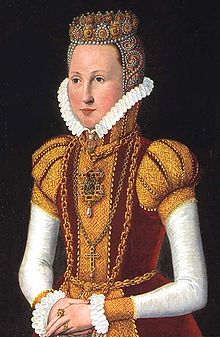Sophie of Mecklenburg (1557–1631)

Sophie, Duchess of Mecklenburg [-Güstrow] (born September 4, 1557 in Wismar , † October 3, 1631 in Nykøbing ) was Queen of Denmark by marriage .
Life
Sophie was the only daughter of Duke Ulrich and his wife Elisabeth of Denmark . At the age of 14 she married her cousin, King Frederick II of Denmark , 23 years her senior, in Copenhagen Castle . Despite the age gap, it was a harmonious marriage. However, since she viewed her husband's behavior as a bad example, she sent her three oldest children to their mother to raise. Sophie accompanied her husband on trips around the country and collected folk songs published by Anders Sørensen Vedel . She was also interested in science. a. Tycho Brahe and was considered one of the most educated queens of her time.
She was widowed in 1588 at the age of 31. In Denmark , where she was still considered a foreigner, she was not a member of the government council for her underage son Christian IV , but in the duchies of Schleswig and Holstein she became guardian of her son according to German custom and ruled there since 1590. She tried to to have the royal share of Schleswig-Holstein divided between their younger sons. The governor Heinrich Rantzau opposed this plan . She also arranged the weddings of her daughters independently of the Reichsrat and provided them with good facilities. All of this brought them into conflict with the Danish government. The emperor Rudolf II , who was called to act as mediator, declared Christian IV to be of legal age at the age of 15 in 1593. Sophie was exiled to Falster Island in Nykøbing .
Even after Christian took over the government in Denmark, Sophie continued to try to enforce her claims and those of her younger sons, with her father also standing up for her. Sophie finally had to retire to the Cismar monastery in 1594 , which was not part of the royal share but, as the Cismar office, was part of Schleswig-Holstein-Gottorf's territory. Against the will of the Danish Imperial Council, she arranged the wedding of her daughter Augusta to Duke Johann Adolf von Schleswig-Holstein-Gottorf .
She later lived in Nykøbing, studied natural sciences and proved to be a capable manager of her widows' estates on Lolland and Falster. Sophie got very rich and did money business. She lent money to many European princes, including her own son, to finance his military ventures. She loaned her particularly generously to her son-in-law Johann Adolf, who gave her the offices of Kiel, Bordesholm, Lügumkloster and Aabenraa for a total of 300,000 Reichstaler. There she broke with the practice of appointing nobles as bailiffs , a model that Johann Adolf followed, as it saved money on the one hand, and on the other hand was able to curtail the traditionally very strong influence of the nobility in Denmark.
Queen Sophie died on October 4, 1631, the richest woman in the country and was buried in Roskilde Cathedral. A bronze bust of Sophie made by the mannerist Johan Gregor van der Schardt is at Rosenborg Castle .
progeny
Sophie's marriage to King Frederick II of Denmark has seven children.
- Elisabeth (1573–1626) ∞ Duke Heinrich Julius of Braunschweig-Wolfenbüttel
- Anna (1574-1619); ∞ King James I of England
- Christian IV (1577–1648), King of Denmark
- Ulrich Johann (1578–1624), as Ulrich II. From 1603 administrator of the Schwerin Monastery
- Augusta (1580-1639); ∞ Duke Johann Adolf of Schleswig-Holstein-Gottorf
- Hedwig (1581-1641); ∞ Elector Christian II of Saxony
- Johann (1583–1602)
See also
literature
- Funeral Sermon : Regina Sophia laudata, deplorata, & vere demum felix aestimata. 1631. ( digitized version )
- EC Werlauff: Sophia af Meklenborg, Dronning til Danmark og Norge; with Tilbageblik paa de tidligere Slægtsskabsforhold mellem det danske og meklenborgske Regenthuus. In: Historisk Tidsskrift. 1. række, volume 3, 1842 ( tidsskrift.dk ).
- JA Fridericia: Sophie . In: Carl Frederik Bricka (Ed.): Dansk biografisk Lexikon. Tillige omfattende Norge for Tidsrummet 1537-1814. 1st edition. tape 16 : Skarpenberg – Sveistrup . Gyldendalske Boghandels Forlag, Copenhagen 1902, p. 165-167 (Danish, runeberg.org ).
- Sebastian Joost: Sophie. In: New German Biography (NDB). Volume 24, Duncker & Humblot, Berlin 2010, ISBN 978-3-428-11205-0 , p. 590 f. ( Digitized version ).
Web links
Individual evidence
- ↑ CR Rasmussen, E. Imberger, D. Lohmeier, I. Mommsen: The princes of the country - dukes and counts of Schleswig-Holstein and Lauenburg . Wachholtz Verlag, Neumünster 2008, p. 152
- ↑ Tomb (Danish)
| predecessor | Office | Successor |
|---|---|---|
| Dorothea of Sachsen-Lauenburg | Queen of Denmark and Norway 1572–1588 |
Anna Katharina of Brandenburg |
| personal data | |
|---|---|
| SURNAME | Sophie of Mecklenburg |
| ALTERNATIVE NAMES | Sophie of Denmark; Sophie of Mecklenburg-Güstrow; Sophie |
| BRIEF DESCRIPTION | Wife of King Friedrich II of Denmark, Duchess of Mecklenburg, Queen of Denmark and Norway |
| DATE OF BIRTH | September 4, 1557 |
| PLACE OF BIRTH | Wismar |
| DATE OF DEATH | October 3, 1631 |
| Place of death | Nykøbing |